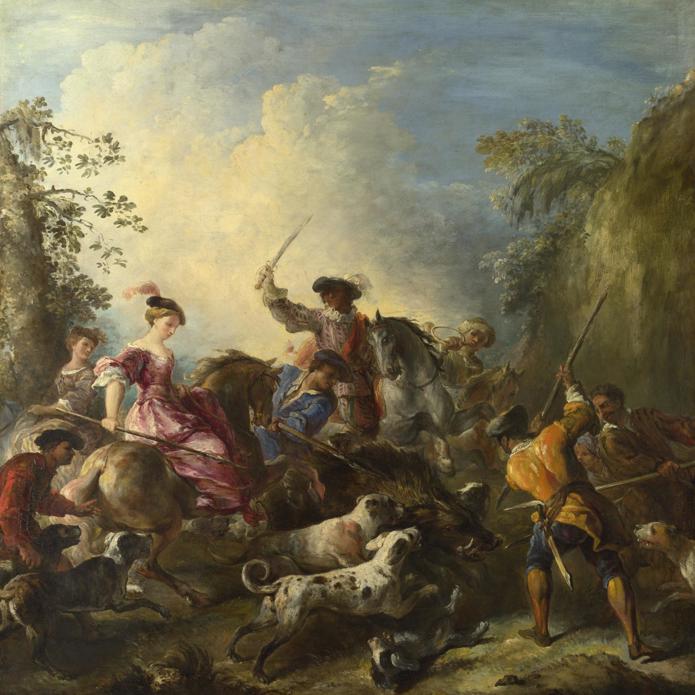Joseph Parrocel, 'The Return from the Hunt', about 1700
About the work
Overview
Elegant couples rest after the hunt in an idyllic sunlit landscape, reflecting the traditional association of hunting and courtship. The gushing fountain, the woman holding flowers and the flirtation between the man holding a falcon and his companion add to the light-hearted romantic atmosphere. Falconry was a popular aristocratic pursuit.
Dogs stare longingly at a group of dead animals in the bottom left corner. While the hare and duck were presumably victims of the falcon, the deer, boar and bugle allude to an earlier scene depicted in The Boar Hunt, a companion painting also in the National Gallery which conveys rapid movement and tension.
This subject was influenced by seventeenth-century Dutch scenes of everyday life and in turn set a precedent for later depictions of groups of figures in idealised settings, known as fêtes galantes. The bright colouring and visible brushstrokes suggest the influence of the celebrated Flemish painter Peter Paul Rubens (1577–1640).
Key facts
Details
- Full title
- The Return from the Hunt
- Artist
- Joseph Parrocel
- Artist dates
- 1646 - 1704
- Part of the series
- Two Hunting Scenes
- Date made
- about 1700
- Medium and support
- oil on canvas
- Dimensions
- 109 × 104 cm
- Acquisition credit
- Bought, 1982
- Inventory number
- NG6474
- Location
- Not on display
- Collection
- Main Collection
- Frame
- 18th-century French Frame (original frame)
Provenance
Additional information
Text extracted from the ‘Provenance’ section of the catalogue entry in Humphrey Wine, ‘National Gallery Catalogues: The Seventeenth Century French Paintings’, London 2001; for further information, see the full catalogue entry.
Bibliography
-
1985National Gallery, The National Gallery Report: January 1982 - December 1984, London 1985
-
2001H. Wine, National Gallery Catalogues: The Seventeenth Century French Paintings, London 2001
-
2001
C. Baker and T. Henry, The National Gallery: Complete Illustrated Catalogue, London 2001
About this record
If you know more about this work or have spotted an error, please contact us. Please note that exhibition histories are listed from 2009 onwards. Bibliographies may not be complete; more comprehensive information is available in the National Gallery Library.
Images
About the series: Two Hunting Scenes

Overview
These two paintings, which were made as companion works to hang together, show the moments during and after a gallant hunt for wild animals. The Boar Hunt, a scene of suspense, drama and movement, can be seen as a nod to the aristocratic hunting scenes painted by Dutch artists in the second half of the seventeenth century. It is paired with The Return from the Hunt, which is altogether more peaceful and is closer in spirit to the fêtes galantes of Parrocel’s near-contemporary, Jean-Antoine Watteau, which show elegantly costumed figures in parkland settings.
Parrocel mainly painted battle scenes, particularly the military conquests of the French King Louis XIV, as well as hunting subjects, many of which were royal commissions. The Boar Hunt and The Return from the Hunt were painted in about 1700, probably for the King, who gave them to his son, Louis Alexandre de Bourbon, the Count of Toulouse. They have magnificent frames decorated with carved animal heads, which were probably made around the same time.


